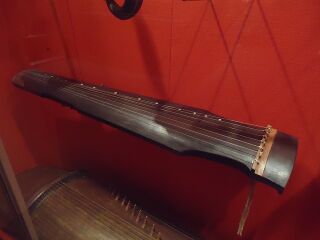Qin
- This page is about the musical instruments. For other meanings of the word Qin, see Qin (disambiguation).
- Chinese/Japanese: 琴 (qín / kin), 古琴 (gǔqín / kokin)
The qin is a traditional Chinese musical instrument. A thirteen-stringed zither, it is closely related to the guzheng and to the Japanese koto. The standard form of the qin is said to date back to the Han Dynasty (c. 206 BCE-220 CE), and is the instrument most classically associated with the literati.
The instrument is spoken highly of by Confucius, among many others, and is said to have a variety of metaphysical characteristics and abilities, including communicating one's character and emotions; cultivating personal character & morality; subduing demons and evil spirits; and enhancing life and enriching learning. Images and descriptions of literati (C: wénrén, J: bunjin) playing musical instruments most often refers to the qin; musical ability and cultivation as one of the Four Accomplishments of the Confucian gentleman likewise refers most typically to the qin, over other instruments. These images and descriptions most often show a literatus playing the qin in a garden, mountain retreat, or otherwise out in nature.
The strings of the qin are traditionally made of twisted silk, while the body of the instrument is made of two kinds of wood, with the upper board of wutong wood representing heaven, and the lower board of zi wood representing earth. Thirteen studs, called hui, mark finger positions.
References
- Gallery labels, Musical Instruments gallery, Metropolitan Museum.
